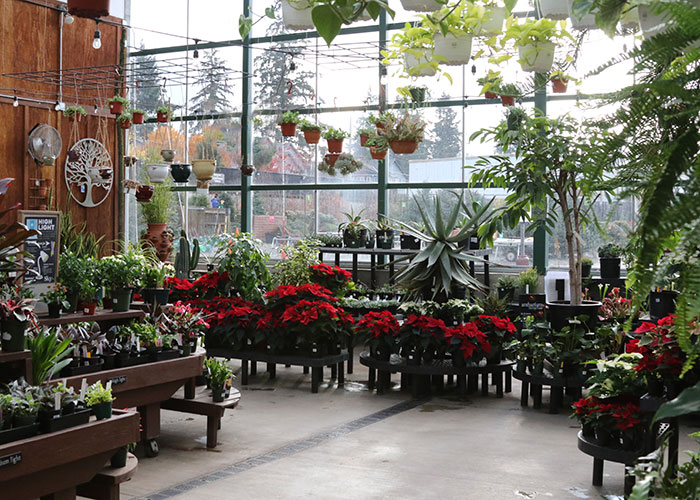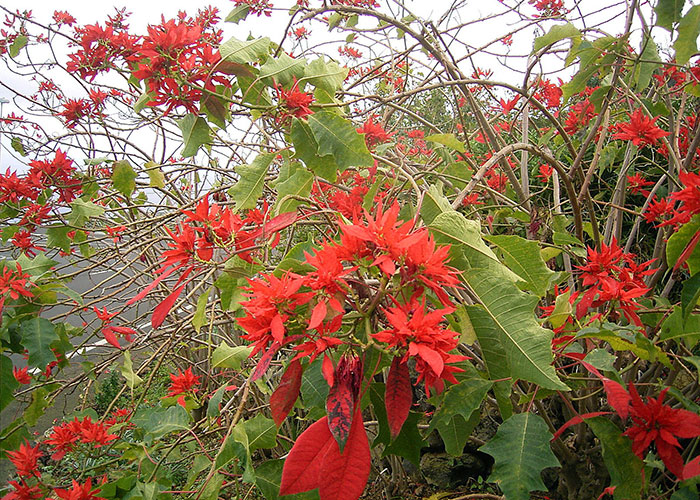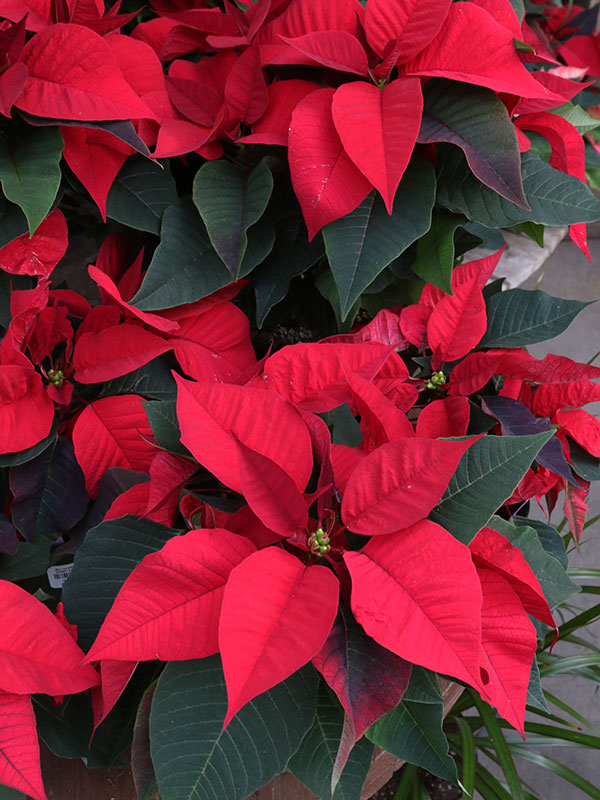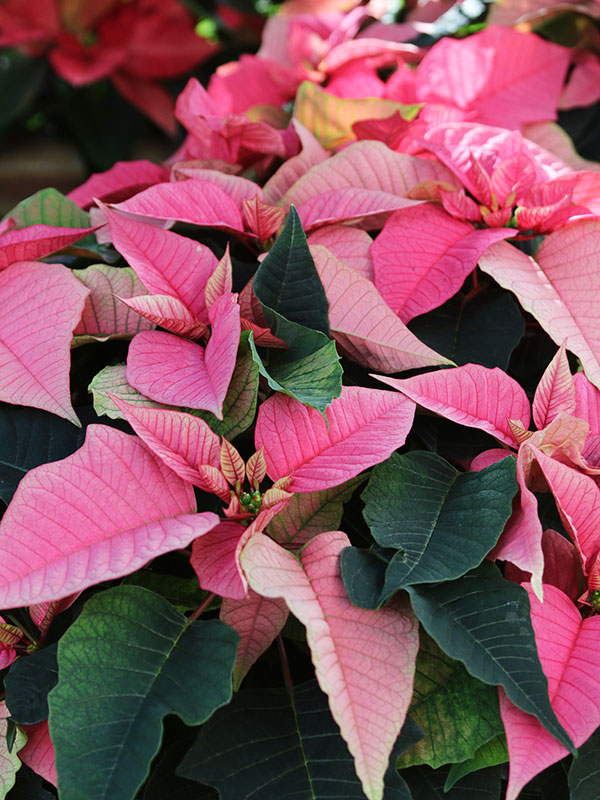Poinsettias: A Little History & A Lot of Tips

There’s no question that people love poinsettias. At Sky alone, we sell over a thousand poinsettias every winter.
But for all their popularity, poinsettias remain deeply — and some might even say tragically — misunderstood. We’d like to lay some myths to rest, help you get to know your botanical holiday guests a little better, and maybe even help you keep your poinsettias thriving throughout the year.

From Forest to Banquet Table
When many North Americans picture poinsettias, they may think of fragile and ephemeral seasonal decorations, no more than a foot or so tall, and likely surrounded by shiny foil. However, this is quite different than what they look like in the wild.
On the tropical mountain slopes of their native Mexico, Euphorbia pulcherrima are large and lanky shrubs that can almost resemble vines. They thrive on seasonally dry tropical slopes in the understory of taller trees. Indigenous uses for the plant include medicine and dyes.
The plants we now know as poinsettias found their way to the United States via the first U.S. ambassador to Mexico, Joel Roberts Poinsett, in 1828. It didn’t take long for the brilliant red and green plants to catch on as house plants. By 1836, they were being cultivated and sold for that purpose.
Although these winter-blooming flores de noche buena (for non-spanish speakers: "flower of the good night") had long been associated with Christmas in Mexico before they made their way to the United States, their popularity as holiday decorations north of the border came about due to an intentional promotion campaign that peaked in the 1960s.
"these winter-blooming 'flores de noche buena' had long been associated with Christmas in Mexico before they made their way to the United States"

Bracts, in Fact
The famously colorful bits of poinsettias aren’t actually flowers: they’re bracts, which is a botanical term for specialized leaves. The flowers themselves are unassuming little yellow puffs, while the bracts color up brilliantly each season.
This is a handy adaptation from the plant’s point of view. Bracts serve the same function as colorful petals by attracting pollinators, but they save on energy since the plant only needs to re-pigment existing leaves rather than growing extravagant, energy-consuming flowers.
"The famously colorful bits of poinsettias aren't actually flowers..."
Winter Poinsettia Care
Keeping poinsettias beautiful and happy through the holiday season isn’t difficult. But when something goes wrong, it’s usually for one of these common reasons:
Not Enough Light
While they may be understory plants in the tropics, they need as much light as we can give them up here in the Pacific Northwest. It’s okay to move them wherever you want them to look pretty temporarily, but they should spend most of their time near a very sunny window.
Temperature is too Low or Variable
Remember: these are tropical plants. They don’t like temperatures below 60 degrees fahrenheit, and they definitely don’t like temperature changes. Even a brief draft can cause them to go downhill quickly. At Sky, we provide sleeves for protection because even the brief trip through cold air from our store to your car or your car to your home can affect them. Once they are home, definitely keep them away from any drafty doors, and make sure their foliage doesn’t touch the windows.
Too Much Water
One of the most common problems people have with poinsettias is over-watering. Check the soil before you water. When it’s dry to the touch, take your plants out of any decorative coverings and water generously. Make sure the pot drains fully before you put them back inside of anything that will prevent drainage. Then wait until the soil dries before watering again.
"At Sky, we provide sleeves for protection because even a brief trip through cold air can affect them"
Year-Round Winter Poinsettia Care
Ever since their popularization as temporary decorations in the 1960s, disposing of poinsettias along with other temporary decorations has become a common practice. But with a little patience, it’s possible to keep them as attractive houseplants year-round and even to coax them into blooming again each holiday season. Here’s how to go about it:
Enjoy through the winter
As long as the colorful bracts last, just keep enjoying your poinsettias, using the care tips above. Just be sure that they are getting plenty of light, infrequent but deep watering, and stable temperatures.
Spring pruning
Once the flowers and bracts begin to fade in the spring, cut the plants back hard, to about 6-8” tall. This will keep them looking like tidy, compact house plants instead of scraggly shrubs. If your plants have outgrown their containers, this is also a good time to repot them.
Summer maintenance
Through the summer, all of your poinsettia leaves will be green, but they will still make attractive indoor plants. Care for them as you would any tropical house plants through the summer, and pinch them back as needed to help them stay compact.
Now for the tricky part
Poinsettias rely on day length as their cue to bloom. To make sure they get the message, cultivated poinsettias need to be kept in total darkness for 12-14 hours per day starting in mid-October. You don’t want to allow them even a glimmer of light during this time. Some people place them in a closet, or under a box. However, they’ll still need bright light the rest of the day. You may want to use an alarm, so you don’t forget to move your plants. Keep this up until the bracts start to color up again, then put the plants back on their regular winter care routine. The process may be time-consuming, but many indoor gardeners find it rewarding and fun.
"Through the summer, all of your poinsettia leaves will be green, but they will still make attractive indoor plants."

Don't worry about Toxicity
Despite their popularity, poinsettias have acquired an unearned reputation for toxicity. All plants in the Euphorbia genus produce a milky sap that can irritate the skin of people who are sensitive to it. But other than that, poinsettias are relatively harmless. They are even about as safe as most houseplants for cats and dogs, although they can cause a bit of an upset stomach or some mouth irritation if eaten.
"Poinsettias are relatively harmless."
Pretty Magnificent Plants
Hopefully, you can enjoy your poinsettias even more this season, having gotten to know them a little better. And whether you keep them growing year after year or simply enjoy them for a single season, these beautiful bracts can be an endless source of fascination and decoration.
